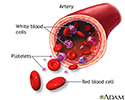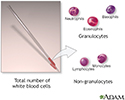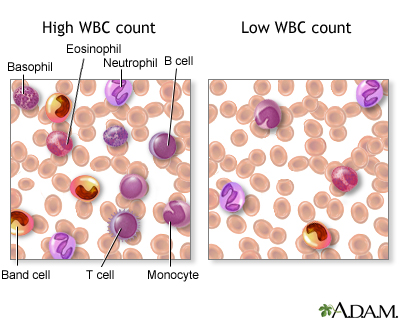WBC count
Leukocyte count; White blood cell count
A WBC count is a blood test to measure the number of white blood cells (WBCs) in the blood.
WBCs help fight infections. They are also called leukocytes. There are five major types of white blood cells :
Five major types of white blood cells
The blood differential test measures the percentage of each type of white blood cell (WBC) that you have in your blood. It also reveals if there are...

- Basophils
-
Eosinophils
Eosinophils
An absolute eosinophil count is a blood test that measures the number of white blood cells called eosinophils. Eosinophils become active when you ha...
 ImageRead Article Now Book Mark Article
ImageRead Article Now Book Mark Article - Lymphocytes (T cells, B cells, and Natural Killer cells)
- Monocytes
- Neutrophils
How the Test is Performed
A blood sample is needed.
Blood sample
Venipuncture is the collection of blood from a vein. It is most often done for laboratory testing.

How to Prepare for the Test
Most of the time, you do not need to take special steps before this test. Tell your health care provider the medicines you are taking, including the ones without a prescription. Some drugs may change the test results.
How the Test will Feel
When the needle is inserted to draw blood, some people feel moderate pain. Others feel only a prick or stinging. Afterward, there may be some throbbing or slight bruising. This soon goes away.
Why the Test is Performed
You will have this test to find out how many WBCs you have. Your body produces more WBCs for several reasons. The most common reasons are when you have an infection or allergic reaction. You can also have more WBCs when you are under stress or have inflammation. Some people naturally have a "normal" high or low number of WBCs. An increased number of WBCs can be due to a blood cancer, such as leukemia or lymphoma.
Normal Results
The normal number of WBCs in the blood is 4,500 to 11,000 white blood cells per microliter (mcL) or 4.5 to 11.0 x 10^9/L.
Normal value ranges may vary slightly among different labs. Some labs use different measurements or may test different specimens. Talk to your doctor about your test results.
What Abnormal Results Mean
LOW WHITE BLOOD CELL (WBC) COUNT
A low number of WBCs is called leukopenia. A WBC count below 4500 is below normal
One type of white blood cell is the neutrophil. This type of white blood cell is important for fighting infections.
- An adult with fewer than 1700 neutrophils in a microliter of blood or 1.7 x 10^9/L has a low white blood cell count.
- If there are fewer than 500 neutrophils in a microliter of blood or 0.50 x 10^9/L, the risk for infection becomes even higher.
It may be due to:
- Bone marrow deficiency or failure (for example, due to infection, tumor, or abnormal scarring)
- Cancer treating drugs, or other medicines (see list below)
- Certain autoimmune disorders such as lupus
- Disease of the liver or spleen
- Radiation treatment for cancer
-
Certain viral illnesses, such as
mononucleosis (mono)
Mononucleosis (mono)
Mononucleosis, or mono, is a viral infection that causes fever, sore throat, and swollen lymph glands, most often in the neck.
 ImageRead Article Now Book Mark Article
ImageRead Article Now Book Mark Article - Cancers that damage the bone marrow
- Very severe bacterial infections
HIGH WHITE BLOOD CELL COUNT
A high number of WBCs is called leukocytosis. It may be due to:
-
Aplastic anemia
Aplastic anemia
Aplastic anemia is a condition in which the bone marrow does not make enough blood cells. Bone marrow is the soft, tissue in the center of bones tha...
 ImageRead Article Now Book Mark Article
ImageRead Article Now Book Mark Article - Certain drugs or medicines (see list below)
- Cigarette smoking
- Not having a spleen, due to spleen removal
- Infections, most often those caused by bacteria
- Inflammatory disease (such as rheumatoid arthritis or allergy)
-
Leukemia
Leukemia
Leukemia is a type of blood cancer that begins in the bone marrow. Bone marrow is the soft tissue in the center of the bones, where blood cells are ...
 ImageRead Article Now Book Mark Article
ImageRead Article Now Book Mark Article - Severe mental or physical stress
- Tissue damage (for example, burns)
There may also be less common reasons for this result.
Drugs that may lower your WBC count include:
- Antibiotics
- Anticonvulsants
- Anti-thyroid drugs
- Arsenicals
- Captopril
- Chemotherapy drugs
- Chlorpromazine
- Clozapine
- Diuretics
- Histamine-2 blockers
- Sulfonamides
- Quinidine
- Terbinafine
- Ticlopidine
Drugs that may increase WBC counts include:
- Beta adrenergic agonists (for example, albuterol)
- Corticosteroids
- Epinephrine
- Granulocyte colony stimulating factor
- Heparin
- Lithium
Risks
Veins and arteries vary in size from one patient to another, and from one side of the body to the other. Obtaining a blood sample from some people may be more difficult than from others.
Other risks associated with having blood drawn are slight, but may include:
- Excessive bleeding
- Fainting or feeling lightheaded
- Hematoma (blood accumulating under the skin)
- Infection (a slight risk any time the skin is broken)
References
Vajpayee N, Graham SS, Bem S. Basic examination of blood and bone marrow. In: McPherson RA, Pincus MR, eds. Henry's Clinical Diagnosis and Management by Laboratory Methods . 22nd ed. Philadelphia, PA: Elsevier Saunders; 2011:chap 30.
-
Basophil (close-up) - illustration
Basophils are a specific type of white blood cell. These cells are readily stained with basic dyes (this is where the name comes from). Note the dark grains inside the cellular fluid (cytoplasm) of this basophil. Basophils make up only a small portion of the number of white blood cells but are important parts of the body's immune response. They release histamine and other chemicals that act on the blood vessels when the immune response is triggered.
Basophil (close-up)
illustration
-
Formed elements of blood - illustration
Blood transports oxygen and nutrients to body tissues and returns waste and carbon dioxide. Blood distributes nearly everything that is carried from one area in the body to another place within the body. For example, blood transports hormones from endocrine organs to their target organs and tissues. Blood helps maintain body temperature and normal pH levels in body tissues. The protective functions of blood include clot formation and the prevention of infection.
Formed elements of blood
illustration
-
White blood cell count - series
Presentation
-
Basophil (close-up) - illustration
Basophils are a specific type of white blood cell. These cells are readily stained with basic dyes (this is where the name comes from). Note the dark grains inside the cellular fluid (cytoplasm) of this basophil. Basophils make up only a small portion of the number of white blood cells but are important parts of the body's immune response. They release histamine and other chemicals that act on the blood vessels when the immune response is triggered.
Basophil (close-up)
illustration
-
Formed elements of blood - illustration
Blood transports oxygen and nutrients to body tissues and returns waste and carbon dioxide. Blood distributes nearly everything that is carried from one area in the body to another place within the body. For example, blood transports hormones from endocrine organs to their target organs and tissues. Blood helps maintain body temperature and normal pH levels in body tissues. The protective functions of blood include clot formation and the prevention of infection.
Formed elements of blood
illustration
-
White blood cell count - series
Presentation
Review Date: 1/27/2015
Reviewed By: Yi-Bin Chen, MD, Leukemia/Bone Marrow Transplant Program, Massachusetts General Hospital, Boston, MA. Also reviewed by David Zieve, MD, MHA, Isla Ogilvie, PhD, and the A.D.A.M. Editorial team.






